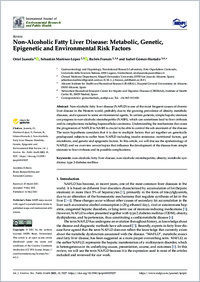Non-alcoholic fatty liver disease : metabolic, genetic, epigenetic and environmental risk factors
- Juanola, Oriol Gastroenterology and Hepatology, Translational Research Laboratory, Ente Ospedaliero Cantonale, Bellinzona, Switzerland - Faculty of Biomedical Sciences, Università della Svizzera italiana, Switzerland
- Martínez-López, Sebastián Clinical Medicine Department, Miguel Hernández University, San Juan de Alicante, Spain - Alicante Institute for Health and Biomedical Research (ISABIAL), Hospital General Universitario de Alicante, Alicante, Spain
- Francés, Rubén Clinical Medicine Department, Miguel Hernández University, San Juan de Alicante, Spain - Alicante Institute for Health and Biomedical Research (ISABIAL), Hospital General Universitario de Alicante, Alicante, Spain - Networked Biomedical Research Center for Hepatic and Digestive Diseases (CIBERehd), Institute of Health Carlos III, Madrid, Spain
- Gómez-Hurtado, Isabel Alicante Institute for Health and Biomedical Research (ISABIAL), Hospital General Universitario de Alicante, Alicante, Spain - Networked Biomedical Research Center for Hepatic and Digestive Diseases (CIBERehd), Institute of Health Carlos III, Madrid, Spain
-
14.05.2021
Published in:
- International journal of environmental research and public health. - MDPI. - 2021, vol. 18, no. 10, p. 24
Non-alcoholic fatty liver disease
Non-alcoholic steatohepatitis
Obesity
Metabolic syndrome
Type 2 diabetes mellitus
English
Non-alcoholic fatty liver disease (NAFLD) is one of the most frequent causes of chronic liver disease in the Western world, probably due to the growing prevalence of obesity, metabolic diseases, and exposure to some environmental agents. In certain patients, simple hepatic steatosis can progress to non-alcoholic steatohepatitis (NASH), which can sometimes lead to liver cirrhosis and its complications including hepatocellular carcinoma. Understanding the mechanisms that cause the progression of NAFLD to NASH is crucial to be able to control the advancement of the disease. The main hypothesis considers that it is due to multiple factors that act together on genetically predisposed subjects to suffer from NAFLD including insulin resistance, nutritional factors, gut microbiota, and genetic and epigenetic factors. In this article, we will discuss the epidemiology of NAFLD, and we overview several topics that influence the development of the disease from simple steatosis to liver cirrhosis and its possible complications.
- Language
-
- English
- Classification
- Medicine
- License
- Open access status
- gold
- Identifiers
-
- RERO DOC 333700
- DOI 10.3390/ijerph18105227
- ARK ark:/12658/srd1319371
- Persistent URL
- https://n2t.net/ark:/12658/srd1319371
Statistics
Document views: 275
File downloads:
- Texte intégral: 384
